KAMMEKO
Helping and rewarding consumers for picking up eco behaviors
Web App, Social Innovation
Overview
kammeko is a web app that provides a fun way of picking up eco-friendly consumption behaviors through a stamp reward system.
I worked on this project as the main UX/UI designer, in collaboration with the entire kammeko team (particularly the CEO, development team, as well as our visual & service designers). I created a style guide, turned insights from ideation sessions and initial usability tests into wireframes, converted them into high-fidelity UI screens and crafted a prototype.
My Role/s
- UX/UI Designer (main)
Services/Methods
- User research
- Wireframing
- User interface design
- Visual design
- Ideation
- Prototyping
Deliverables
- Style Guide
- UI screens
- Prototype
- User research insights
35
SCREENS DESIGNED
5
ITERATIONS
2
APP MODES (VENDOR & CONSUMER)
Challenge
Helping consumers adopt eco-friendly spending habits
People worldwide have become more conscious of the negative impacts climate change has brought upon in recent years. In light of this, there's an ever-growing movement to shift to more sustainable business practices and lifestyle choices.
Individually however, there is an on-going struggle among those who desire to live more sustainably. We wanted to create a digital product for consumers with the following pain points, who need help in their transition to a more eco-friendly lifestyle and spending.
- Lack of knowledge on how to live eco-friendly
- Not knowing where and how to start
- The financial cost of switching to a more sustainable way
- Feeling of helplessness/guilt of not doing enough
- Lack of choices on where to shop
Outcome
kammeko app
We launched the beta version of kammeko, which helps users pick up eco behaviors through a stamp collection reward system involving eco-friendly shops and restaurants. These stamps when accumulated will help them complete challenges within the app and earn rewards.
Project Context
Before my onboarding to the project, discovery sessions were conducted to define our target users, get clear on their pain points and kammeko's value proposition.
We have ideas on how the product can address our target users' needs, but these can only be verified once we have an MVP ready for the market. Moreover, in Japan (Tokyo in particular), various social impact-related products have been launched, and albeit being around for a while, there isn't currently a widely-used habit-building app for sustainability.

"MyMizu" lets you discover places where you can refill your bottle for free and eliminate the need for plastic bottles.
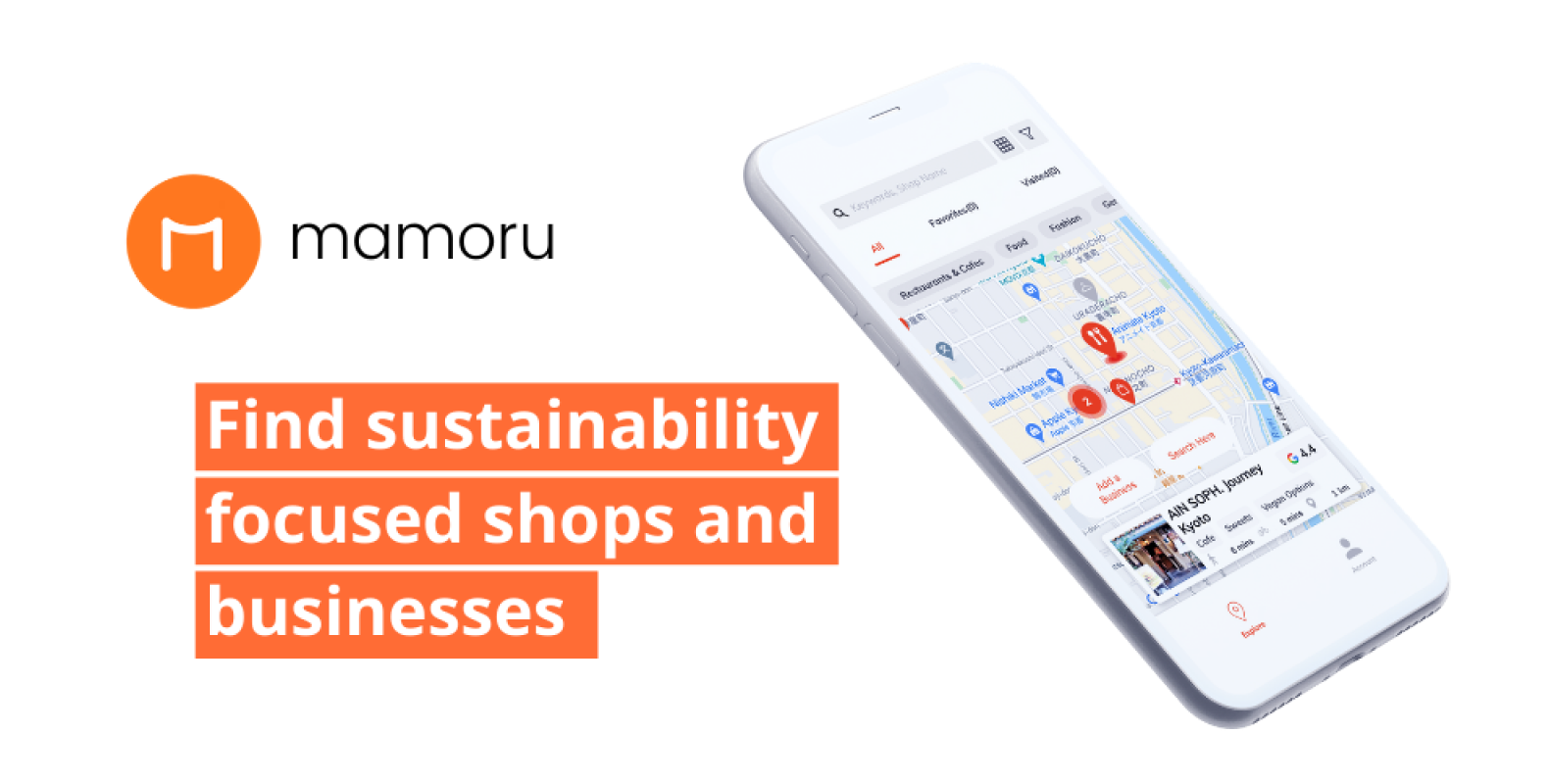
"Mamoru" introduces users to sustainable businesses through a curated map.
Given the time constraints and limited manpower resources, we set our goal of launching kammeko at the earliest timing to quickly either confirm or debunk our initial assumptions and get a more accurate response from both consumers & vendors on the product's overall value.
Approach
Building a win-win product for both eco-consumers & eco-businesses
Conceptualizing the product
Customer loyalty programs such as membership point cards and stamp collection for rewards are quite common and considered a standard practice among retail brands in Japan. Our team leaned on this as we delved into various ways of implementing a system that helps consumers pick up sustainable behaviors and incentivizes them, while giving them the pleasure of discovering eco-friendly shops that will support their lifestyle change.
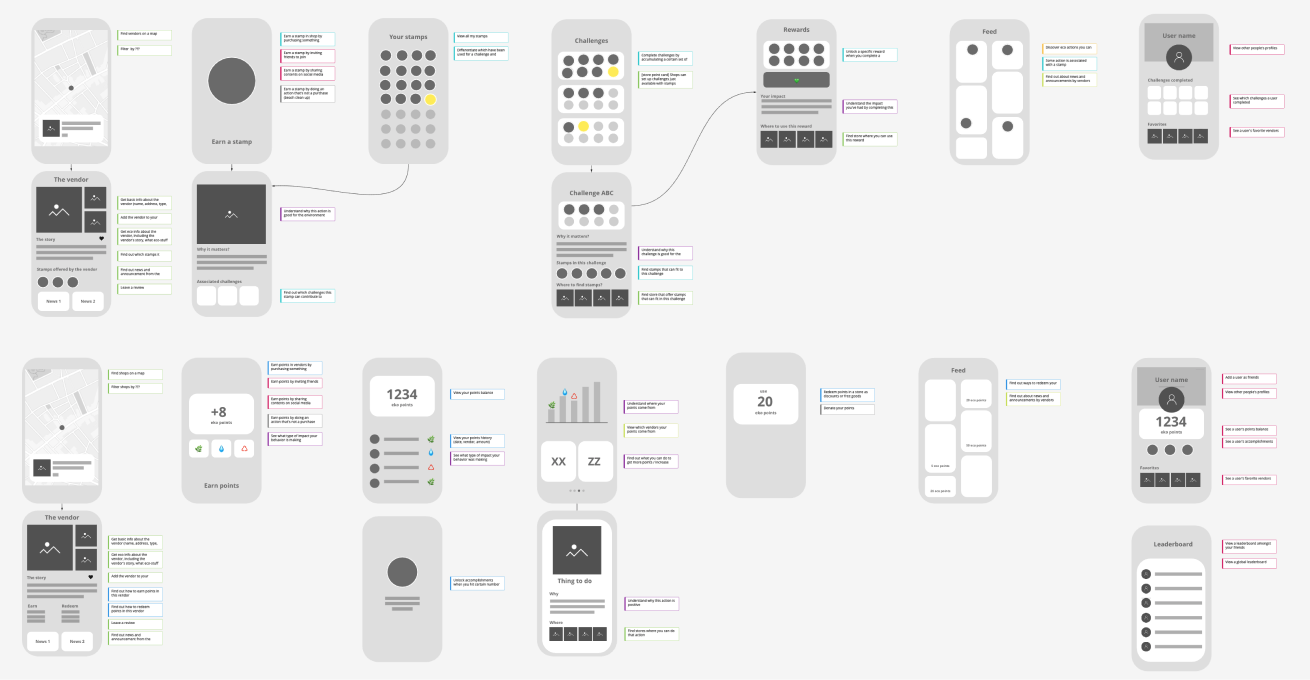
Rough concept explorations.
Introducing eco behaviors through a stamp reward system
Ultimately, we adopted the stamp reward system as the app’s mental model due to its established familiarity among consumers, and qualitative way of tracking eco-behavior performance.
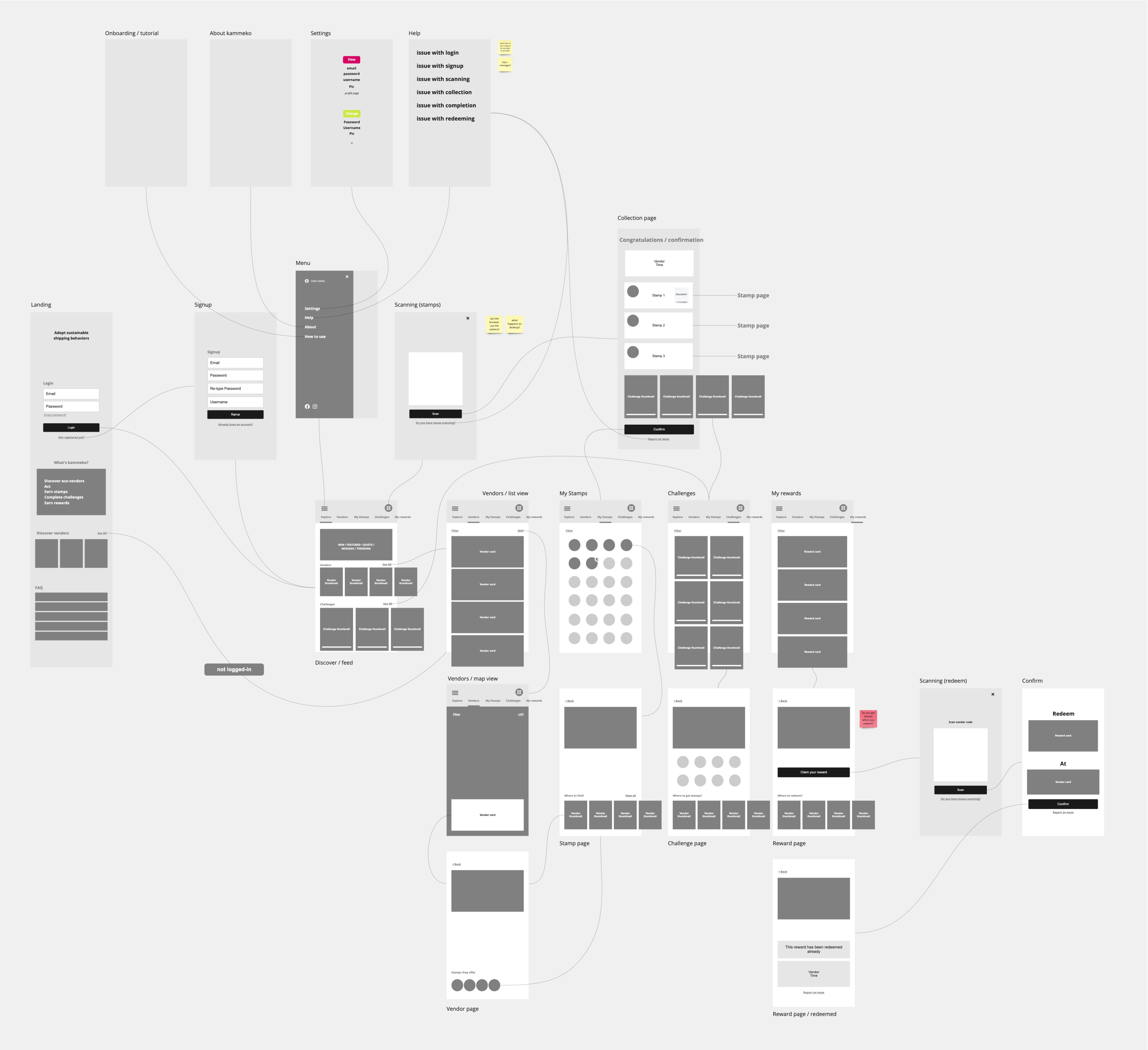
Initial wireframes and user flow.
Building the foundation
Setting up the style guide. kammeko’s brand exudes lightness, ease and fun. This is reflected in the style guide - from the pastel colors, to the gradients and typeface.
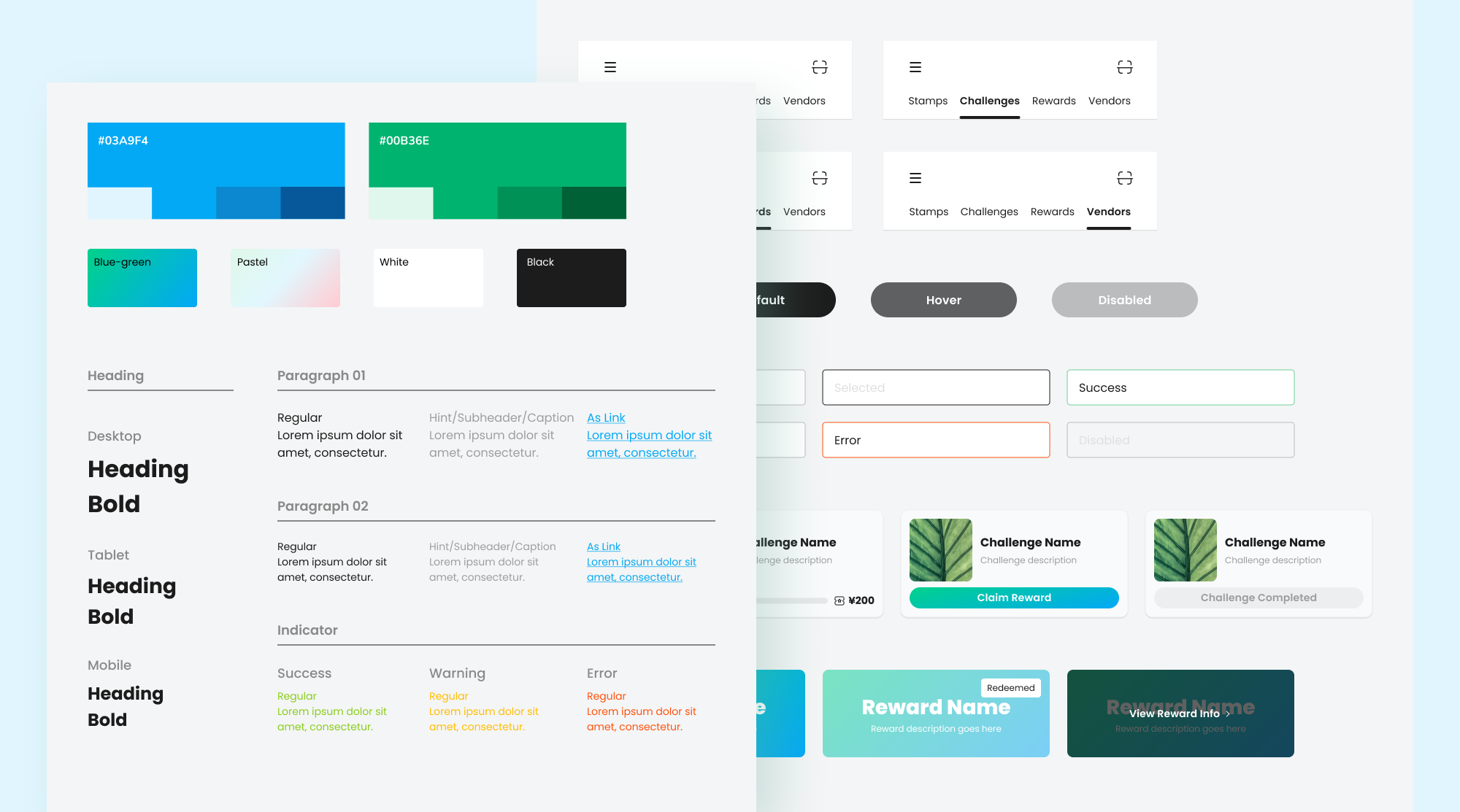
Solution
An app introducing eco behaviors & eco businesses to consumers
Showcasing the eco behavior stamps
Going for simplicity. The screens’ layout were designed to convey a clean aesthetic and showcase the stamps’ colorful and playful style.
Making the distinction from a curation app
From its inception, we intended kammeko to be a tool that helps users progress in their eco journey, and not just a curation of eco shops (which how other apps already are). This objective is made clear by having the stamps page as the default page when user logs in.

Upon login, users can see the stamps they can collect, which represents an eco behavior.

Stamps are collected via QR code at a kammeko-affiliated vendor.

Each stamp collected automatically contributes to a challenge. Once completed, user can claim a reward.

Rewards can be redeemed in any of the kammeko-affiliated vendors.

Lastly, users can browse through all the shops/restaurants that can support their eco journey and where they can collect stamps.
Vendor-side kammeko app
Given how kammeko works on the user-side, a vendor-side application is also needed to issue stamps and rewards. The app was made for tablet, since most shops/restaurants in Tokyo use it to transact with customers. Its single-screen, straightforward design makes issuing stamps & rewards as swift as possible.
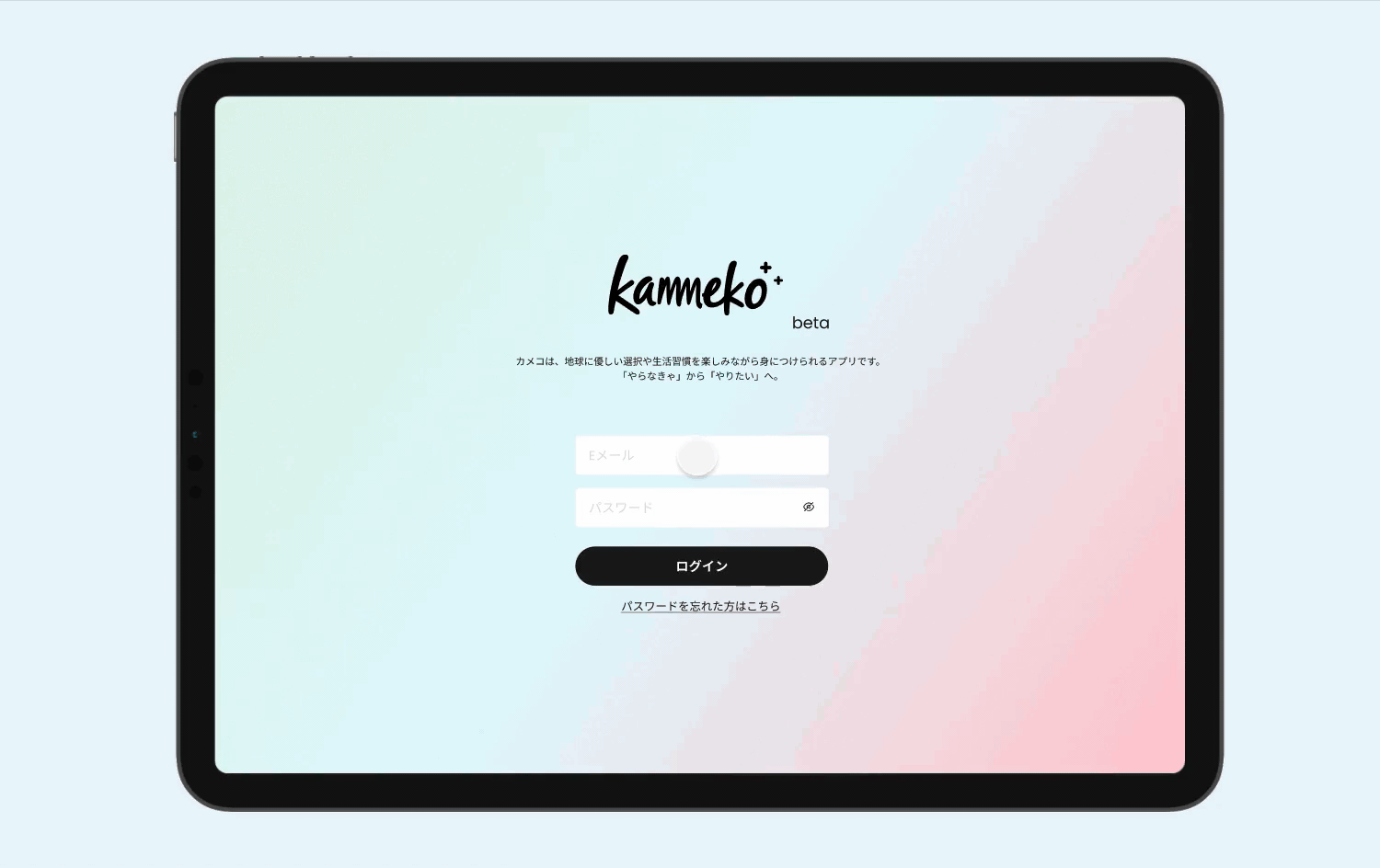
Validation
Product beta launch and customer reception
After releasing the beta version, user and on-site vendor interviews, as well as surveys were conducted to gather feedback on the app’s hits and misses. We had the following objectives:
User Interviews & Surveys
Know where they're at in their eco-journey, how they discovered kammeko and what their impressions are, as well as feedback on the app's usability.
Store On-site Field Research
Learn about vendors' understanding of kammeko, the way they introduce it to customers, and how the app's promotional materials are displayed in the shops.
What's next
Given the feedback gathered and the patterns we observed on how users, as well as vendors utilize and perceive the app, it was evident we needed to do the following to improve the user experience:
- Make kammeko a native mobile app
- Re-think how stamp collection and challenges work
- Make the process of collecting stamps more engaging and fun
- Present shop information more concisely, with relevant content for users
- Simplify in general how kammeko can help users build eco-habits
- Make the app bilingual for foreigners
Takeaways
Valuing the importance of releasing a product before it's "ready"
When the team started building kammeko, we weren't 100% certain on our expectations how the product will be received, and we focused on shipping it rather than spending rigorous effort on trying to get it "right".
The acceptance of the product being imperfect (especially as a beta version) allowed us to hit our target release timing and learn immediately what resonates with the users and areas for improvement.
